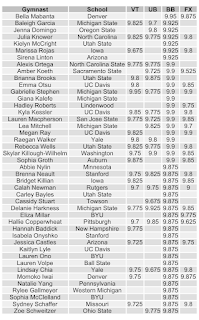A thoughtful question came up
on Twitter yesterday:
I have the RTN data scraped for all scores reported from 1998 to 2022 so far (through January 17), so I checked. According to that data, there have been 718 10s scored and 434 have them have been by a gymnast competing at home. That means 60% of 10s are scored at home, which is more than half, but it doesn’t seem too out of the ordinary at first glance.
One thing I hadn’t considered until seeing this question is how many meets are home vs. how many are away. Since meets can (and do) often have more than one away team, in the entire dataset, there are more away scores than home scores.
In fact, of the scores on RTN from 1998-2022, just 37% are home scores.
 |
| Counts of home and away scores 1998-2022 |
|
 |
(blue line is average percentage)
|
|
|
37% of all scores are scored at home, yet 60% of 10s are scored at home. This plot shows the percentage of each score from 9.0 to 10.0 scored at home (scores from judging panels > 2 are excluded so that only scores ending in .x0, .x25, .x5, and .x75 are included)

When we take this into account, we see that .21% of home scores are 10s, but just .082% of away scores are 10s.
Proportion of home scores that are 10s: 434/205014 = .002117
Proportion of away scores that are 10s: 284/344638 = .0008241
We often set this sort of data up in a 2x2 table like this:
| 10 | not 10 |
Home | 434 | 204580 |
Away | 284 | 344354 |
Similarly, the odds of a 10 at home (total 10s at home divided by total non-10s at home) is .0021 and the odds of a 10 away (total 10s away divided by total non-10s away) is .00082.
Odds of 10 at home: 434/204580 = .002121
Odds of 10 away: 284/344354 = .0008247
These numbers are very similar to the proportion of home scores that are 10s and proportion of away scores that are 10s because 10s are relatively rare.
This means the odds ratio for scoring at 10 at home is 2.57. Odds ratio = odds of 10 at home/odds of 10 away.
Odds ratio: .002121/.0008247 = 2.57
(some rounding has occurred throughout when reporting the numbers)
This means the odds of scoring a 10 at home is about 2.57 times the odds of scoring a 10 away.
If we were to do the same calculation using 9.8s (just 9.8s exactly, not 9.8 and greater) scored home and away, we’d get this:
Home 9.8s = 13974
Home not 9.8s = 191040
Away 9.8s = 21524
Away not 9.8s = 323114
So, our 2x2 table looks like this:
| 9.8 | not 9.8 |
Home | 13974 | 191040 |
Away | 21524 | 323114 |
Odds of 9.8 at home = 13974/191040 = .07315
Odds of 9.8 away = 21524/323114 = .06661
Odds ratio = .07315/.06661 = 1.10
The odds of scoring a 9.8 at home is only 1.1 times the odds of scoring a 9.8 away.
Some things to keep in mind here:
This doesn’t account for anything other than being home or away. It’s not a rigorous/thorough analysis so we have to be careful what kind of conclusions (if any) we draw from it.
One big weakness here is that it’s very likely that schools who are more likely to score 10s are also more likely to host home meets. That means that while there may be a real “home teams score more 10s” type of effect, we can’t completely separate it from “10s teams host more meets.” Likewise, there might be other factors at play here in similar ways.
From the table and plot, it looks like there has been some variation in the percentage of home meets over time. There are probably multiple things factoring into these trends, none of which are really being accounted for here. Also, some of the earlier data on RTN tends to be less complete.















